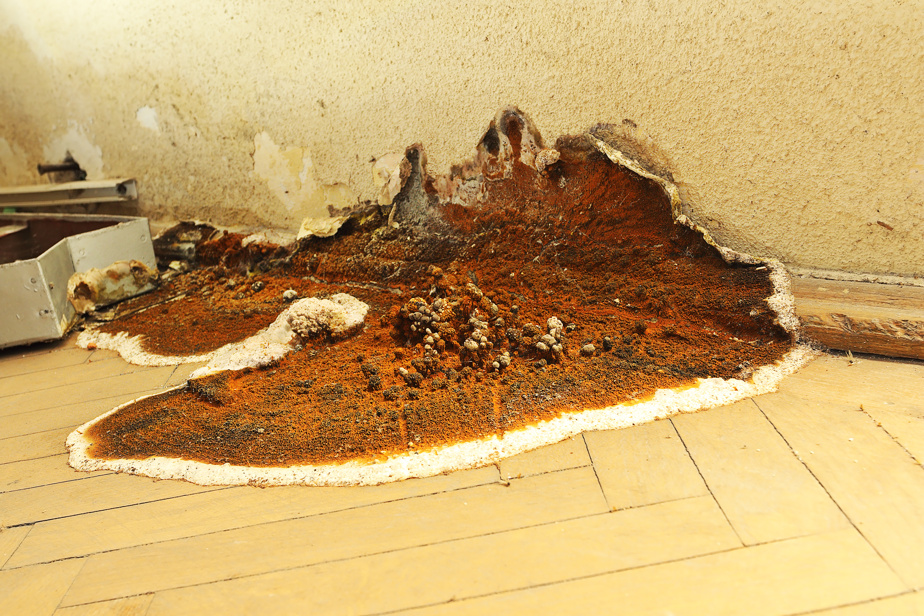The Press : Weeping dry rot is nicknamed “building cancer”. Why?
Marie-Hélène Cauchon: Dry rot is a fungus that feeds on wood, which makes it much more damaging to buildings than other fungi. It is more aggressive and more difficult to eradicate. It starts in damp, dark places, such as crawl spaces. Its main characteristic is that its root system can carry water, which allows it to spread in dry places. In one of the phases of its development, it develops a tolerance to light and begins to emerge from the bottom of walls. By the time people notice the problem, the fungus will have already caused a lot of damage behind it.
What kind of damage?
-

PHOTO PROVIDED BY MÉRULE QUÉBEC
Here we see a weeping dry rot that has contaminated a crawl space.
-

PHOTO PROVIDED BY MÉRULE QUÉBEC
The sporophore, reproductive organ of the weeping dry rot
1/2
Contaminated wood disintegrates and loses its load-bearing capacity, which weakens the entire structure of the building.
Is it dangerous for the health of residents?
This is a tricky question. Dry rot is not a direct health hazard, but it thrives in a cocktail of molds. These molds can aggravate or trigger respiratory diseases such as asthma.
Is its appearance in Quebec recent?
This is a very old fungus native to the Himalayas. Its first record in Quebec dates back to the 1940s, but the first documented case dates back to 2010. Several new cases have appeared over the last decade. The reasons? First, climate change is creating more favorable conditions for fungi. And then, we are insulating our homes more, which risks causing an accumulation of humidity if there is an undetected water infiltration.

PHOTO PROVIDED BY MÉRULE QUÉBEC
Sometimes it is necessary to destroy houses contaminated by dry rot.
Is it possible to save an affected building?
It will depend a lot on the stage at which the problem is discovered. If it is caught relatively early in a corner of the basement, decontamination can solve the situation. However, if the fungus has spread to the central beams and the floors are contaminated, the project becomes very expensive. And when it is caught too late, it is sometimes necessary to completely demolish the building.
How widespread is the phenomenon?
It is difficult to know its extent in Quebec. We must count on the collaboration of laboratories to notify us when they find a positive test result. But several large laboratories refuse to participate, under the pretext of confidentiality. We have drawn up a geographic census map, but it is a big Swiss cheese. It is full of holes.

PHOTO PROVIDED BY MÉRULE QUÉBEC
Marie-Hélène Cauchon, director of Mérule Québec
How was the Mérule Québec organization born?
Following the contamination of our home in 2014, my partner and I went to the media to speak out about our situation and to ask for help. At the time, the government claimed that it was a personal problem. But we realized the extent of the problem when other affected homeowners found us on social media. Together, we created this organization, which became legal in 2018.
You even obtained financing from the Société d’habitation de Québec.
A pilot project at the time allowed the implementation of an initial financial assistance program. Now, we have changed government, we have completely changed our approach. The program has become very difficult to access for people who need it. And now, we see that the government is gradually moving towards closing the program, under the pretext that it is not used very much by owners. But it is the eligibility criteria that cause this situation. It is like a wheel turning in the wrong direction.
Why is it difficult to qualify for the program?
The program is very flexible for owners who bought before October 2018. It becomes very strict for others. We scrutinize the inspection report and if we see the words “fungus” and “mold”, we automatically exclude them.
Isn’t compensation for fungus infestation the purpose of the program?
You understood it quickly. The housing stock is old and it is not uncommon to see mold somewhere. This criterion therefore makes a very large number of houses ineligible, particularly heritage buildings and houses that are part of an estate. The program lacks a lot of nuances. It practically only covers new houses for which people normally have other recourses. We are also looking for testimonials from people who are refused access to the financial assistance program of the Société d’habitation de Québec. It is possible to answer a questionnaire on our website. This allows us to understand the reality and needs of owners excluded from the program.
How much compensation is offered?
At 75% of costs up to a maximum amount of $90,000 for decontamination and $150,000 for demolition-reconstruction.
What is the deadline for submitting an application?
People have until December 31 to open a file. And until March 31, 2025 to have access to financial assistance. We really feel that we are heading towards the end. It is very deplorable because Europe has been greatly inspired by our program. We are developing unique expertise in the fight against this scourge that threatens our built heritage. We are missing an opportunity to become world leaders.
Visit the Mérule Québec website
